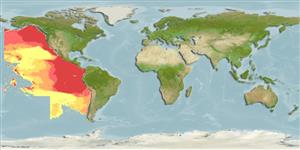Classification / Names
Nombres comunes | Sinónimos | Catalog of Fishes(Género, Especie) | ITIS | CoL | WoRMS | Cloffa
>
Lophiiformes (Anglerfishes) >
Gigantactinidae (Whipnose anglers)
Etymology: Gigantactis: Greek, 'gigas' or 'gigantos' = gigantic + Greek, 'aktis' = ray (referring to the unusually long first dorsal-fin spine that functions as a lure in this genus) (Ref. 86949).
Environment: milieu / climate zone / depth range / distribution range
Ecología
marino batipelágico; rango de profundidad 700 - 915 m (Ref. 86949). Deep-water
Pacific Ocean.
Tamaño / Peso / Age
Maturity: Lm ? range ? - ? cm
Max length : 12.7 cm SL (female)
Short description
Morfología | Morfometría
Espinas dorsales (total): 0; Radios blandos dorsales (total): 5-6; Espinas anales 0; Radios blandos anales: 4 - 6. Length of illicium 216-240% SL; escal bulb with 8-10 distal appendages; longest rays of caudal fin 31-42% SL (Ref. 41361); have an exceptionally short dentary teeth (longest 1.1-1.6%SL); escal bulb with short distal prolongation pigmented on distal surface; escal papillae absent; proximal escal papillae absent; dentary teeth arranged posteriorly in two longitudinal series; weakly developed skin coverage of proximal part of caudal fin; caudal fin rays free nearly to base (Ref. 86949).
Known from 8 specimens (Ref. 41361).
Life cycle and mating behavior
Madurez | Reproducción | Puesta | Huevos | Fecundidad | Larva
Bertelsen, E. and T.W. Pietsch, 2002. New species of deep-sea anglerfish of the genus Gigantactis (Lophiiformes: Gigantactinidae) from the western North Atlantic Ocean. Copeia 2002(4):958-961. (Ref. 41361)
IUCN Red List Status (Ref. 130435)
Threat to humans
Harmless
Human uses
Más información
Nombres comunesSinónimosMetabolismoDespredadoresEcotoxicologíaReproducciónMadurezPuestaAgregación para la puestaFecundidadHuevosEgg development
Age/SizeCrecimientoLength-weightLength-lengthLength-frequenciesMorfometríaMorfologíaLarvaDinámica larvariaReclutamientoAbundanciaBRUVS
ReferenciasAcuiculturaPerfil de acuiculturaRazasGenéticaElectrophoresesheritabilidadEnfermedadesProcesamientoNutrientsMass conversion
ColaboradoresImágenesStamps, Coins Misc.SonidosCiguateraVelocidadTipo de nataciónSuperficie branquialOtolitosCerebrosVisión
Herramientas
Special reports
Download XML
Fuentes de Internet
Estimates based on models
Preferred temperature (Ref.
123201): 1.7 - 2.1, mean 1.9 °C (based on 464 cells).
Phylogenetic diversity index (Ref.
82804): PD
50 = 0.5000 [Uniqueness, from 0.5 = low to 2.0 = high].
Bayesian length-weight: a=0.01995 (0.00906 - 0.04395), b=3.01 (2.83 - 3.19), in cm total length, based on all LWR estimates for this body shape (Ref.
93245).
Nivel trófico (Ref.
69278): 3.9 ±0.7 se; based on size and trophs of closest relatives
Fishing Vulnerability (Ref.
59153): Low vulnerability (10 of 100).
